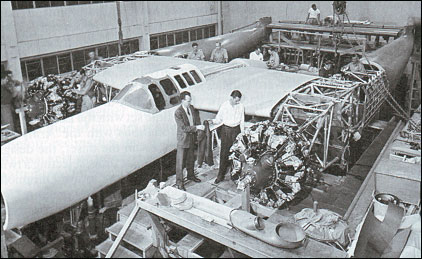|
| There is no text information for this aircraft at the moment.
 | A three-view drawing (1278 x 904) |
| ENGINE | 2 x 2000hp Pratt & Whitney R-2800-49 |
| WEIGHTS |
| Take-off weight | 14366 kg | 31672 lb |
| DIMENSIONS |
| Wingspan | 18.29 m | 60 ft 0 in |
| Wing area | 57.23 m2 | 616.02 sq ft |
| PERFORMANCE |
| Max. speed | 697 km/h | 433 mph |
| Cruise speed | 441 km/h | 274 mph |
| Ceiling | 10975 m | 36000 ft |
| Range | 1610 km | 1000 miles |
| Trevor Webb, e-mail, 29.01.2021 06:10 Apparently the D-2 was built for reconnaissance dutues. However in its short career it was designated XP-73 (it was not a fighter) and XA-37 (it was not an attack aircraft). reply | | Earles L. McCaul, e-mail, 02.04.2016 23:45 Think of the Hughes D2 as being the American counter-part to the British "wooden wonder" Mosquito...both being made of wood, although using different processes: D2 using 'Dura-Mold' and Mosquito using plywood. reply | | Francis Blake, e-mail, 22.02.2016 02:48 I explored the burned D-2 hangar site on Harper Dry Lake, NW of Barstow, in November 2014. I found many bits of pieces including burnt wood, and possibly a partially melted alloy metal piece of the D-2. It has cast and stamped codes on it. Does anyone have D-2 code reference? data? reply | | rantam, e-mail, 06.12.2012 06:33 What is the value of a vintage original engineers' Hughes Aircraft 3 ring binder from 1943 containing original photos of the d-2 blueprints printed on Hughes aircraft logo emblazened photo paper. Not the blueprints themselves but actual photos of the actual blueprints in a Hughes Aircraft stamped denim 3 ring binder. If you reply to this post please email me also as I may not able to find this website again to check the posts. thanks. RanTam111@gmail.com reply | |
| | Dave Harris, e-mail, 22.01.2010 15:47 Like the P-38, the D-2 featured an unusual twin-engine, twin-boom configuration. What made it unique was that it was built of alternating layers of heat-treated wood veneers and epoxy resin glues. This so-called Duramold process enabled exceedingly smooth surfaces. Better still, wood was cheap and widely available. But brief test flights in 1943 exposed the airplane's flaws. "It turned out to be a dog," Burk says. "The ailerons were almost completely ineffective, so it had no lateral control." It was no great loss when the lone D-2 was destroyed in 1944 by a fire said to have been caused by a lightning strike. reply |
|
Do you have any comments?
|
| 
All the World's Rotorcraft |











